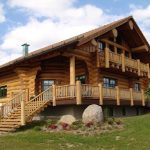
Building professionals all around the world over time have uncovered some great alternative building methods using natural or sustainable materials. Just as any building method, there are pros and cons that surround it. We are going to talk about some of the most popular alternative building materials around the world, this will help us understand the benefits or challenges you may face when building a structure out of these materials.
Earth bags
Building with earth bags dates back centuries. This inexpensive construction method is very simple; take a mix of local soil and clay to develop a strong structure that is quickly built. The process is simple, you will need to fill Polypropylene or Burlap bags with your soil/clay mixture, stack them and being tamping to create a solid base for the next layer. Repeat this process until you have developed your basic structure. Wood framing helps to create windows and doors, while bags filled with gravel may also be used to create a good solid foundation.

Pros:
· Construction Costs – If you are skilled and knowledgeable enough to conquer the construction yourself, you will definitely save a lot of money by not having to pay a contractor to help you. Many people actually gather as many close friends or family that they can to assist them in the construction of their new earthbag home or structure.
· Eco-Friendly – Let’s face it, the reason this method has gained so much popularity is because of the low impact it has on our precious earth.
· Cost of Materials – The cost for most of the materials is fairly low when you compare it to other conventional building methods.
· Energy Efficient – Thick walls make for great insulation against the outside elements.
· Cons:
· Labor – Creating earthen walls that have such a high mass, results in excessive and strenuous labor.
· Difficulty – If you are not working with someone that has had experience in building these types of structures, it can be very difficult to create a safe and efficient structure that can last.
· Upkeep – Because of the materials used, there are repairs that will need to be made more often than a structure made with conventional materials such as, steel, lumber, etc…
· Engineering – Building departments are not as accepting of this method in larger countries. These methods are not taught in schools, so many engineers are not familiar with how forces react with these structures, raising concern over safety and strength.
Straw bale
This building method utilizes bales of straw (wheat, rice, rye etc…) as structural elements or insulation for your structure, sometimes both. Straw bales can be packed to the correct density to create load bearing walls, or they can be used as a great insulation in a method known as Post and Beam. This creates a wall that is much thicker than conventional construction.


Pros:
· Energy Efficient – Thick walls and the great insulation properties that straw bales have, lead to amazing energy efficiency for these structures.
· Less harmful Chemicals and Materials – Not using spray or rigid insulation such as fiberglass, reduces the amount of harmful chemicals found in new homes.
· Low-Embodied Energy – Straw bales are made from the waste of another product and take much less energy to manufacture, considering sunlight was the main source of energy for growing the original plant.
· Fire Resistant – Even though this might not seem logical, straw bale walls if constructed correctly have been proven to be much more flame retardant than conventional lumber-frame construction. The density of the bales tend to contribute to this.
· Cons:
· Not Conventional – This is not a conventional building method and the selected contractor may need to learn new construction techniques.
· Building Codes – It may take a little bit more work to get plans approved if straw bale is not part of your local building codes.
· Humidity – This method is not ideal for humid climates, as the walls need to be kept dry to avoid molding and other damage to the straw bales.
· Thick Walls – Even though thick walls can better your structures energy efficiency, it also means more of your overall square footage will be unusable.



Comments are closed